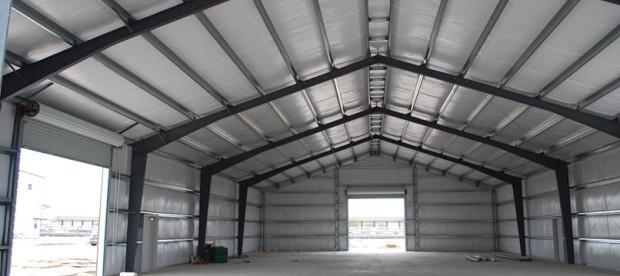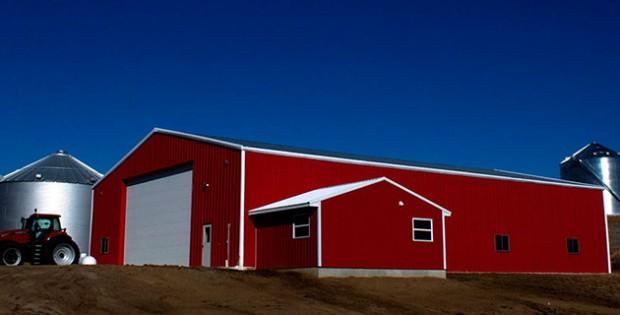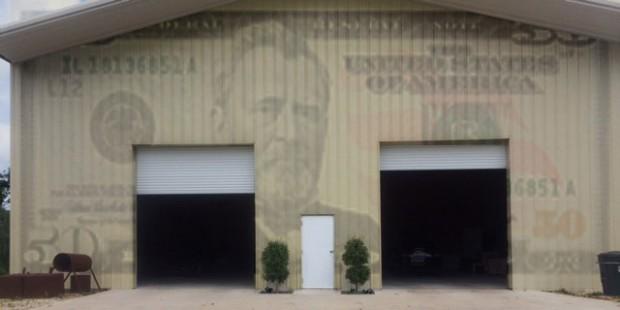What Kind of Insulation Will My Steel Building Need?

When you plan for your steel building, you’ll want to think about insulation. The first question you need to ask yourself: Do I even need it? For residential structures or garages and workshops, usually people spring for some kind of insulation. When it comes to commercial or agricultural buildings, it might not be necessary depending what you are storing or housing.
While steel structures are some of most durable, cost-effective and flexible building solutions on the market, they’re also susceptible to moisture. That’s why I suggest using some kind of insulation, regardless of your building type, to create some kind of moisture blocking system in your building. Plus, you want your building to stay warm in the winter, and cool in the summer, right? Insulation will go a long way to making that happen, and provide a cozy atmosphere all year round. Coupled with the right kind of ventilation, insulation can help defend your steel building against the elements.
How can insulation protect my steel building?
Insulation provides a vapor barrier for your steel building. Not only that, but since steel conducts heat, a building made of steel will transfer heat energy in and out of it. This may cause condensation to occur inside a steel building when there is a considerable temperature difference outside the building. Insulation delivers a material and vapor barrier, protecting the inside of your building – and most importantly – and all the equipment inside it. Insulation also prevents the buildup of condensation, which could eventually lead to rust or mold growth. Work with your project manager to protect your investment by determining the best type of insulation for your building.
What kind of insulation is best for my steel building?
There are quite a few options of insulation to pick for your structure. Your choice depends on your building type, budget, and unique specifications. You want your insulation to have a good R-Value. R-Value is a measurement of the effectiveness of an insulator to retain or impede the loss of heat flow. Think of R-Value like this: the higher the number, the better it will insulate. Pick your R-Value based on your steel building location and climate conditions. As I stated before, good steel building insulation also reduces condensation, installs easily, and reduces the effect of humidity on the insulation. Some of the best insulation is recognized for its energy saving features, or endorsed by Energy Star.
Types of insulation for a steel building
 Blanket insulation – This is most common and widely available type of insulation, and it comes in rolls or ‘batts.’ It is made up of flexible fibers, most commonly fiberglass. There are also batts and rolls made from minerals, like rock and slag, wool, plastic fibers, and natural fibers, like wool and cotton. It’s usually the cheapest insulation option, but many people use it to protect their building against condensation. Most people who own a steel building use blanket insulation for its ability to be easily replaced if necessary.
Blanket insulation – This is most common and widely available type of insulation, and it comes in rolls or ‘batts.’ It is made up of flexible fibers, most commonly fiberglass. There are also batts and rolls made from minerals, like rock and slag, wool, plastic fibers, and natural fibers, like wool and cotton. It’s usually the cheapest insulation option, but many people use it to protect their building against condensation. Most people who own a steel building use blanket insulation for its ability to be easily replaced if necessary.
Loose Fill – This type of insulation consists of small particles of fiber, foam, or other materials. These small particles form an insulation material that can take the shape of any space without disturbing frames or finishes. Its ability to fit in every nook and cranny makes it appropriate for locations where it would be difficult to install other types of insulation. Loose-fill insulation is generally made from fiberglass or cellulose, and is relatively also inexpensive.
 Spray Foam – Spray foam insulation is often times the most expensive options for steel buildings, and sometimes used with different interiors. The liquid foaming agent is sprayed, and expands to fill into any space or cavity, forming an air barrier. Some installations of spray foam insulation can have twice the R-Value per inch or traditional blanket insulation.
Spray Foam – Spray foam insulation is often times the most expensive options for steel buildings, and sometimes used with different interiors. The liquid foaming agent is sprayed, and expands to fill into any space or cavity, forming an air barrier. Some installations of spray foam insulation can have twice the R-Value per inch or traditional blanket insulation.
Rigid Board – Rigid board insulation consists of either fiberglass or mineral wool and is generally used to insulate air ducts in buildings. This type of insulation is also used because of its ability to withstand high temperatures. It’s one of the easiest types of insulation to install, and is typically made from polyurethane or fiberglass. This insulation type can be cut to a desired thickness, and possibly increasing its R-Value if doubled up. One drawback of rigid board insulation is that some types do not provide an adequate vapor barrier.
Which type will you pick for your steel building? When you work with a project manager and determine your steel building accessories, you can determine which insulation works best for your location, your plan and your budget.
Photo courtesy: Anne Swoboda, Dunktanktechnician
Popular Posts

Will Adding a Steel Building Increase My Property Value?
I’ve seen steel buildings increase in popularity every day because builders use these durable, versatile and flexible construction solutions in every application. Not only have homeowners utilized a steel building for residential purposes, but builders have also made additions to their existing property. No doubt that a steel building garage will increase the value of a home,… …

Steel Building Quotes: Get a Grasp on Prices and Estimates
What is the first step of a steel building project, or any construction project for that matter? After you decide to add a new garage, agricultural or commercial building to your property, you’ll most likely start contacting steel building manufacturers for steel building quotes. From there, you can create a timeline for yourself and develop… …

4 Important Factors That Will Impact Your Steel Building Cost
For the past decade, the steel industry has undergone many transformations, and in effect it’s changed the way the construction industry views steel buildings. While the steel itself has been around for hundreds of years, designers and owners of metal buildings are seeing many increased benefits. Because of streamlined processes at manufacturers, energy saving paints… …